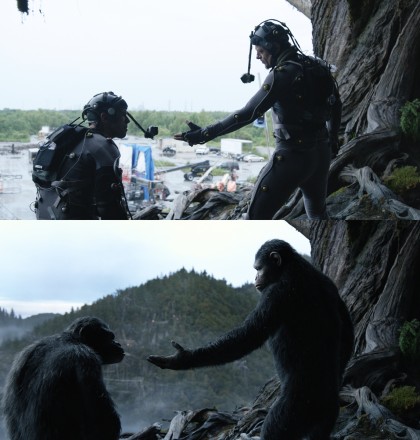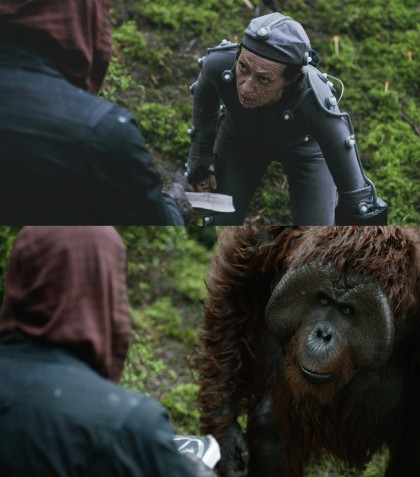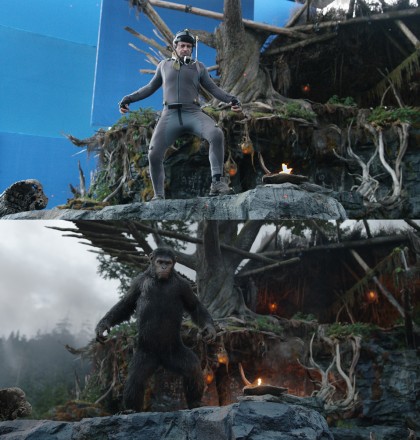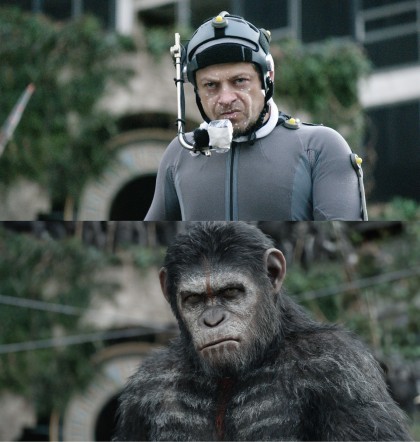How Weta changed motion capture tech for Dawn of the Planet of the Apes
The tech that turned Andy Serkis into an ape

This development allowed the team to mo-cap on set, instead of limiting the filming to the studio in New Zealand.
The battery pack attached to the active mo-cap suit lasted for 2-3 hours, but with the stop/start nature of filming, they replaced the battery packs between takes.
Given the nature of the shooting location for Dawn of the Planet of the Apes in the Canadian rainforest, the Weta team had to create a way to not only condense their setup into a relatively compact solution for easy transport, but also work out how to make the setup waterproof.
"On set, rather than having tens of hours to set everything up and calibrate, we have tens of minutes. We basically have to be able to build the thing really quickly and make adjustments as things change as we're shooting the film," explained Dan Lemmon, Visual Effects supervisor at Weta.
"So we've developed equipment and methodology for having fewer of the cameras to start with and being able to quickly set them up and aim them around and not have so many cables. We've got some new techniques to be able to attach them to places that aren't necessarily very accessible and in some cases are a little dangerous," Lemmon added.

The crew managed to get everything they needed stored into three road cases similar to those used by touring musicians. They also became adept at setting up the capture equipment quickly, as the nature of shooting on location didn't leave a lot of time to stuff around with fine-tuning cameras.
All about the performance
Of course, there's more to the motion capture than just super-tight lycra and fancy infrared cameras.
Sign up for breaking news, reviews, opinion, top tech deals, and more.
These days, it's probably more correct to call the technology "performance capture", as it is a lot more about translating an actor's performance.
During the motion capture for the Apes film, the actors walked around on short crutch-like arm extensions and trained moving like apes to try and mimic how chimps and gorillas move in the real world. Movement is obviously important in capturing believability, but more important is the nuanced performance of the actor.
To capture that nuance, there's a huge emphasis on the actor's face. For a large number of scenes during filming, the actors wore special helmets with mounted cameras that recorded every minute facial expression.

This obviously gave the animators a lot more reference data to work with, allowing them to take the traits of actors and their performances and translate them into animated results.
But what's surprising is just how detailed the team at Weta go with the process.
At the start of filming, Weta seats the actors down in a chair with two mirrors capturing their profile reflection, and makes them pull faces. This gives the animators a solid reference point to help customise a digital ape to the actor playing that role.
"The first part is all motion range of how the eyes affect the eyelids, the eyebags; how much the flesh is on the upper part of his eyes… all those details we incorporate onto Caesar afterwards. Everything is muscle based – everything is based on actual anatomy," explains Alessandro Bonora, lead facial modeller at Weta.

For Andy Serkis' Ceasar, software gave the animators control over 240 muscles in the ape's face, which was carefully matched to Serkis' own facial performance.
While not all of the controls are needed for every character in the film, each rig is created using a combination of both human and ape biology, depending on both the actor and the ape they were playing. Lead villain Koba, for example, was more ape-like than Caesar, but with some very human muscle motion included to sell Toby Kebbell's performance.
One example Bonora gave us was with the platisma muscles – the strong neck muscles that tend to stand out when you're yelling – which are commonly found on the back of an ape, as opposed to the front of the neck. But to capture the intensity of Toby Kebbell's performance, they included them at the front on Koba.
"We take those sort of liberties to improve the quality of the performance," Bonora explains. "Sometimes we go to the extent of matching wrinkles, when the wrinkle or the form is very prominent on the performer."
The future of digital chimps
As impressive as the end result is on Dawn of the Planet of the Apes, the technology behind motion capture is still a long way from perfection.
While there's confidence that the visual effects team can now capture an actor's performance and turn it into a digital character on a one-to-one basis, there's still room for improvement, as Dan Barrett explained.

"I think it's going to get more and more incremental. I think we've made some reasonable leaps over the last few years, and I think it's going to get more and more incremental. But we're always looking to improve, and trying to get our water or rain simulations better, or whatever it might be," Barrett said.
"I think that the more that we can free it up, the more inconspicuous we can be as the team on set - and that's happening thanks to wireless technology and things - we can be out of the way and almost invisible on set."
Dawn of the Planet of the Apes is available on Blu-ray and digital now